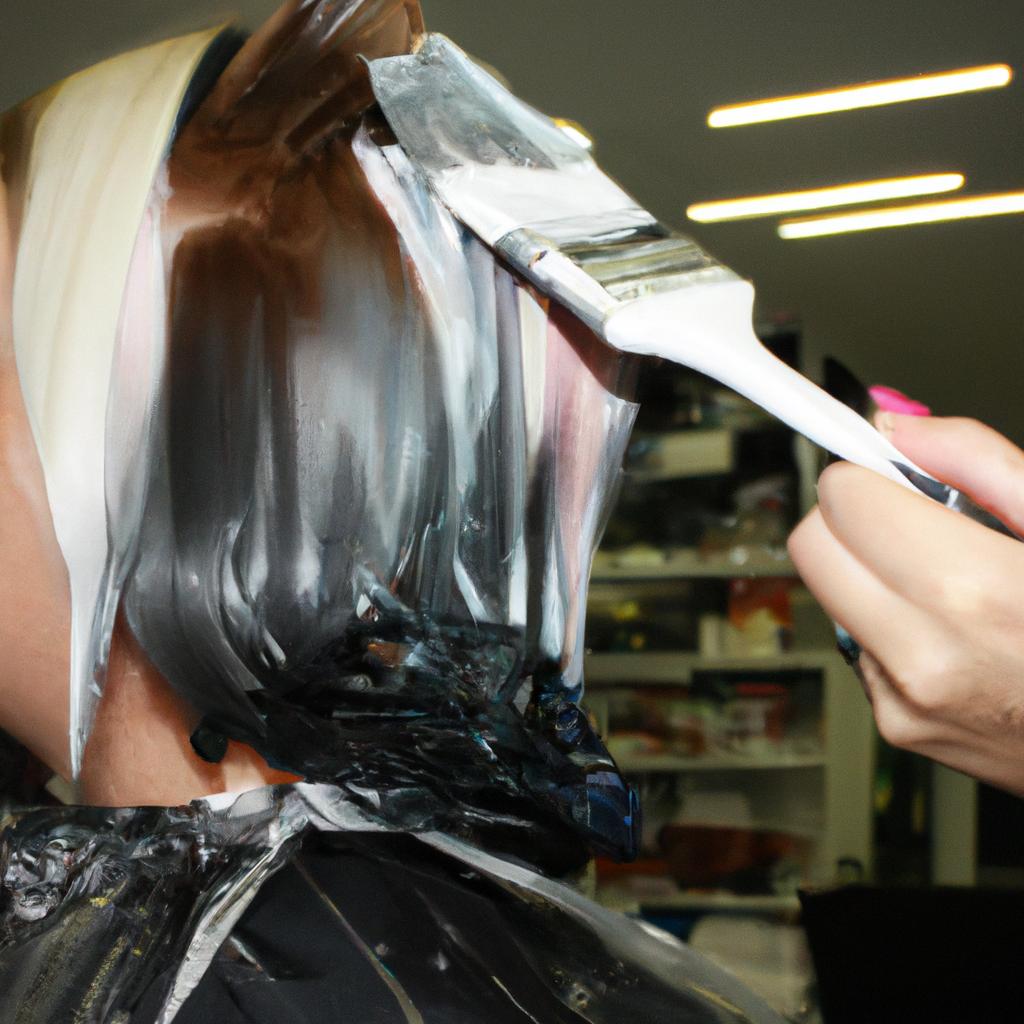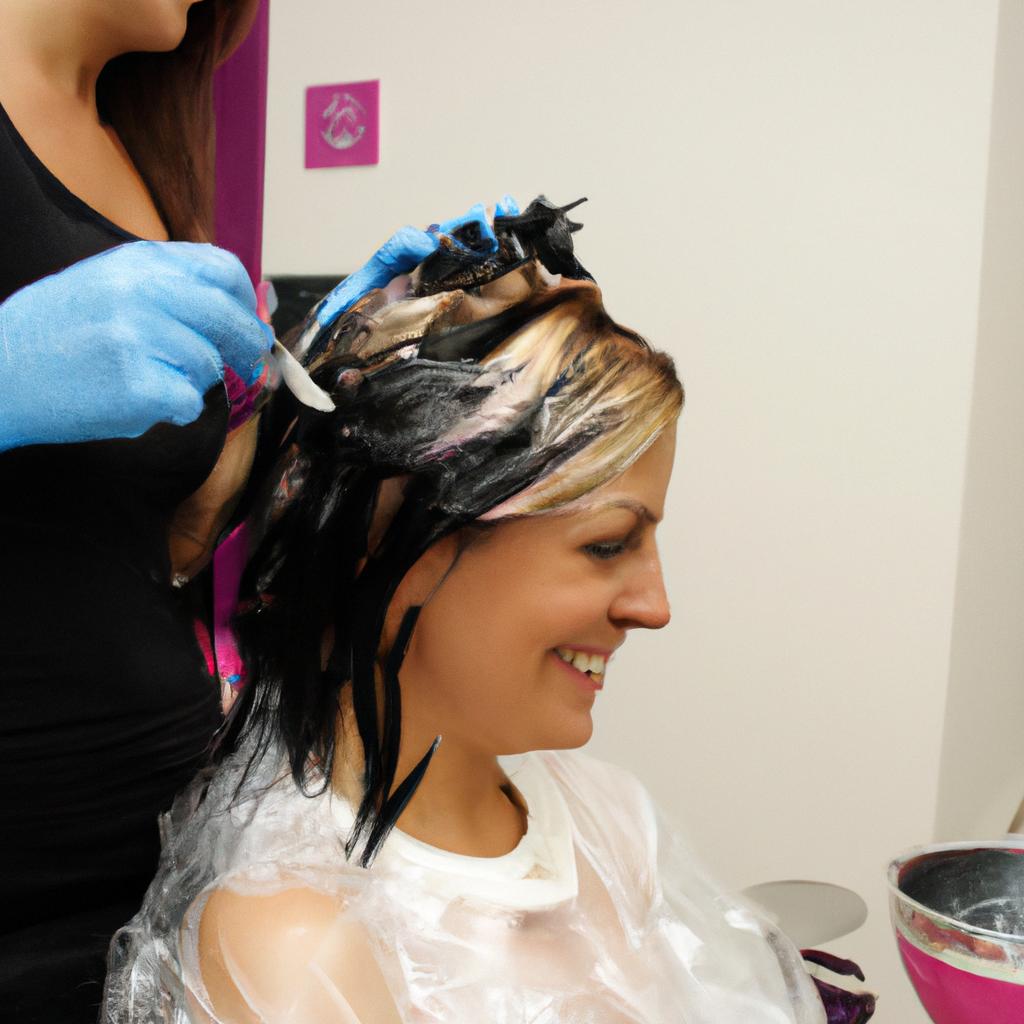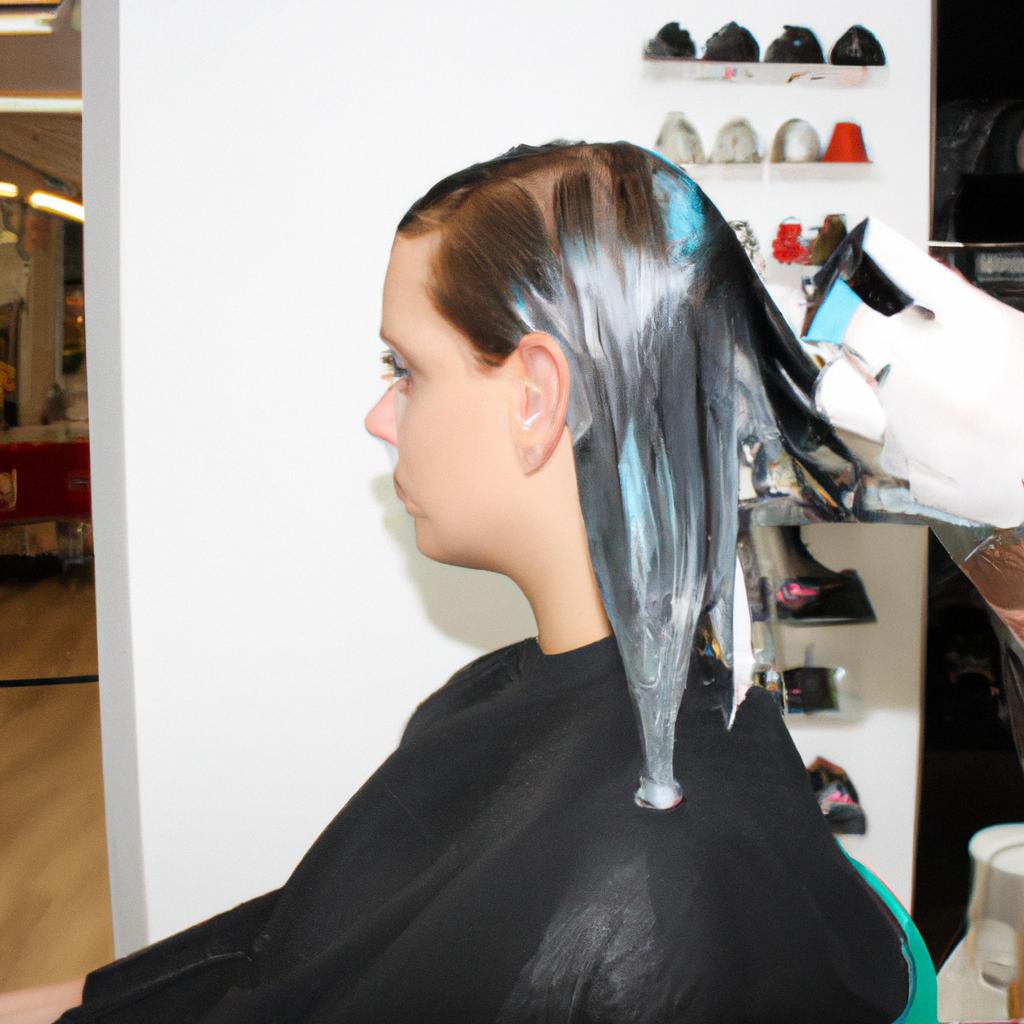Color correction is a common practice in hairdressing salons, where skilled professionals apply various techniques to rectify undesirable color outcomes. This informative guide aims to delve into the intricacies of color correction, providing comprehensive insights for aspiring hairstylists and individuals seeking to understand the process better. To illustrate the significance of this topic, consider a hypothetical scenario: imagine an individual visiting a salon with the intention of lightening their dark brown hair to a soft golden blonde shade but ending up with an unflattering orange hue instead. In such cases, color correction becomes essential to restore the desired outcome and ensure client satisfaction.
The art of color correction requires expertise, precision, and a thorough understanding of principles related to hair pigmentation and formulation theory. Often, undesired results occur due to factors like incorrect application techniques or inadequate knowledge about underlying pigmentations. By comprehending these factors, stylists can analyze the specific issues at hand and develop effective strategies for achieving successful color corrections. This article will explore the key elements involved in color correction processes, including determining underlying pigments, selecting appropriate corrective colors, employing proper application methods, and incorporating necessary aftercare practices. Understanding these aspects not only empowers hairdressers but also promotes customer confidence by assuring them that even the most challenging color mishaps can be rectified with the right approach and expertise.
Determining underlying pigments is a crucial step in color correction. Hair naturally contains different pigments, such as red, yellow, and blue. When attempting to correct a color, it is essential to assess the hair’s current undertones accurately. For example, if the undesired orange hue mentioned earlier resulted from an unsuccessful attempt at lightening dark brown hair, it indicates a high concentration of red pigment. Understanding this underlying pigment helps determine the corrective colors needed to neutralize or counterbalance it effectively.
Selecting appropriate corrective colors involves understanding color theory and how different shades interact with each other. To cancel out unwanted tones like orange or brassiness, complementary colors are used. In this case, a blue-based toner or ash blonde shade would help neutralize the orange undertones and achieve a more desirable result. However, selecting the correct shade requires considering factors like the level of lift achieved during previous coloring processes and the desired end result.
Employing proper application methods is crucial for achieving successful color corrections. This may involve techniques like toning, glazing, or using color removers to eliminate unwanted pigments before applying corrective colors. It may also require precise timing and careful monitoring to prevent over-processing or further damage to the hair. Additionally, using professional-grade products formulated specifically for color correction ensures better results and minimizes potential risks.
Incorporating necessary aftercare practices is vital for maintaining the longevity and integrity of the corrected color. This includes recommending suitable hair care products that are specifically designed for colored hair, advising clients on proper washing techniques (such as using cool water instead of hot), and suggesting regular maintenance appointments to touch up any regrowth or fading.
By understanding these key elements involved in color correction processes and implementing them effectively, hairstylists can confidently address various color challenges presented by their clients. Moreover, clients will feel assured that even the most unexpected or undesirable outcomes can be corrected, resulting in beautiful and satisfying hair transformations.
Understanding the Color Wheel
Imagine a scenario where a client enters your hairdressing salon, desperately seeking help to correct a disastrous at-home hair dyeing experiment. Their once golden blonde locks have turned an unfortunate shade of orange. As a skilled hairstylist, you know that understanding the color wheel is crucial in addressing such color correction challenges.
The color wheel serves as a visual representation of how colors interact with one another. By comprehending its principles, hairdressers can effectively navigate through various hues and tones to achieve desired results for their clients. It provides insight into complementary and contrasting colors, aiding in the selection of appropriate shades for correcting undesirable outcomes.
To grasp the significance of the color wheel in hairdressing, consider these key points:
- Complementary Colors: Opposite colors on the wheel are known as complementary colors. When combined, they create contrast and balance each other out. For example, if faced with overly warm-toned brassy hair, applying a cool-toned ash-based color will neutralize the warmth and restore natural-looking harmony.
- Contrasting Effects: Adjacent colors on the wheel create contrasting effects when used together or side by side. This technique allows hairstylists to add depth and dimension to their clients’ hair by strategically incorporating different shades from neighboring sections of the color wheel.
- Tonal Adjustments: The intensity or vibrancy of a specific hue can be adjusted by altering its tonal value using shades from within its own section on the color wheel. This approach enables precise control over achieving subtle changes while maintaining overall harmony.
- Harmonizing Techniques: Utilizing analogous colors – those found next to each other on the color wheel – helps maintain consistency and cohesion in hair coloring. Selecting analogously related shades minimizes drastic contrasts and ensures smooth transitions between different areas of colored hair.
By employing these techniques derived from an understanding of the color wheel, professionals in hair salons can confidently address even the most challenging color correction scenarios.
Emotional Response:
- Confidence: Armed with knowledge about the color wheel, hairstylists can approach color corrections confidently and offer effective solutions to their clients.
- Creativity: The use of contrasting colors and harmonizing techniques allows hairdressers to showcase their creativity and elevate their craft.
- Satisfaction: Achieving desired results through proper application of color theory brings immense satisfaction both to stylists and their clients.
- Trust: Demonstrating expertise in understanding the color wheel helps build trust between hairstylists and their clientele.
| Benefits of Understanding Color Wheel | Emotional Impact |
|---|---|
| Enhanced confidence in addressing color correction challenges | Increased sense of professionalism |
| Opportunity for creative expression in hair coloring | Excitement and inspiration for stylist’s artistic abilities |
| Ability to achieve client satisfaction by meeting expectations | Fulfillment from delivering successful outcomes |
| Establishment of trust between hairstylist and client | Strengthened professional-client relationship |
With a firm grasp on how the color wheel functions, let us now explore the essential process of determining the desired hair color.
Determining the Desired Hair Color
Understanding the Color Wheel is crucial for hairdressers to effectively perform color correction in a salon. By comprehending how colors interact and complement each other, stylists can make informed decisions when correcting hair color mishaps. For example, let’s consider a scenario where a client comes into the salon with brassy orange tones after attempting an at-home bleach job. The use of the color wheel would help identify which complementary shade to apply in order to neutralize the unwanted warmth.
When it comes to color correction, there are several key factors that come into play:
- Undertones: Understanding undertones is essential as they determine whether a hair color appears warm or cool. Warm undertones have hints of red, orange, and yellow, while cool undertones lean towards blue and violet shades.
- Complementary Colors: Knowing which colors are opposite on the color wheel helps identify corrective shades. For instance, green counteracts red tones, purple cancels out yellow hues, and blue neutralizes orange.
- Corrective Pigments: Hair coloring products often contain specific pigments designed to counteract unwanted tones. These pigments work by depositing their own hue onto the hair shafts to achieve balance.
- Pre-lightening: In some cases, pre-lightening may be necessary before applying corrective colors. This step allows the stylist to lighten the existing hair color so that subsequent toning or coloring can produce desired results.
To further illustrate these concepts visually, here is an emotional bullet point list highlighting important aspects of understanding the color wheel:
- Discovering how certain colors cancel out others brings harmony back to botched dye jobs.
- Utilizing complementary shades creates stunning transformations and boosts clients’ confidence.
- Learning about corrective pigments empowers stylists to correct even the most challenging situations.
- Mastering pre-lightening techniques opens up endless possibilities for creative expression.
Additionally, visual aids such as tables can provide clear guidance during the color correction process. Here is an example of a table showcasing complementary colors and their corresponding corrective effects:
| Unwanted Tone | Complementary Color | Corrective Effect |
|---|---|---|
| Red | Green | Neutralize |
| Orange | Blue | Counteract |
| Yellow | Purple | Cancel out |
By employing these strategies, hairdressers can confidently approach color corrections, ensuring clients leave the salon with beautiful and desired results.
Identifying the Natural Hair Color
Once you have thoroughly assessed the client’s hair and identified their natural color, it is crucial to determine the desired hair color. This step plays a significant role in achieving successful color correction results. Let us consider an example: A client with naturally dark brown hair desires to achieve a vibrant blonde shade.
To ensure that you accurately understand your client’s expectations, effective communication is key. Engage in open-ended conversations to grasp their vision clearly. Ask questions about specific shades or show them swatches of different colors for reference. Taking into account their skin tone and eye color can also help guide the decision-making process.
Here are some important factors to consider when determining the desired hair color:
- Undertones: Determine whether warm or cool undertones would complement the client’s complexion.
- Maintenance Level: Assess if the desired shade requires frequent touch-ups or if they prefer a low-maintenance option.
- Lifestyle Factors: Consider how well the chosen hair color will align with the client’s lifestyle, such as work requirements or personal preferences.
- Professional Advice: Provide expert guidance by suggesting suitable options based on their natural hair characteristics and desired outcome.
| Factor | Description |
|---|---|
| Undertones | Warm or Cool |
| Maintenance Level | High or Low |
| Lifestyle Factors | Work Requirements, Personal Preferences |
| Professional Advice | Expert Guidance |
By taking these aspects into consideration, you can assist your clients in making informed decisions about their desired hair color while considering various factors that may impact its long-term maintenance and suitability. With clear communication channels established and thorough understanding achieved, you can move forward confidently towards selecting the appropriate hair dye for your client’s needs.
With the desired hair color determined, let us now explore how choosing the right hair dye contributes to achieving optimal results.
Choosing the Right Hair Dye
To ensure a successful color correction process, it is crucial to accurately identify the client’s natural hair color. Let us consider an example of a client who has naturally dark brown hair and desires to achieve a vibrant shade of platinum blonde.
In order to determine the starting point for this transformation, several factors need to be considered:
-
Undertones: Natural hair colors often have underlying undertones such as warm (red or orange), cool (blue or violet), or neutral tones. Identifying these undertones is essential as they can significantly impact how certain dyes will interact with the hair.
-
Previous Color Treatments: It is important to assess any previous color treatments that may have been applied to the hair. These could include permanent or semi-permanent dyes, highlights, or balayage techniques. Understanding what has already been done to the hair will help in determining the appropriate steps for achieving the desired result.
-
Texture and Porosity: The texture and porosity of the hair play a significant role in how well it absorbs and retains color. Fine, porous hair may require different techniques compared to coarse, non-porous hair. Evaluating these characteristics will guide decisions on product selection and application methods.
Now let’s take a closer look at some key points to keep in mind when identifying natural hair colors:
| Points to Consider |
|---|
| Existing shades present in the client’s hair |
| Any variations in tone throughout different parts of the head |
| The presence of gray or white hairs |
| Overall condition and health of the hair |
By considering these aspects, you can gain valuable insights into your client’s natural base and make informed decisions about how best to proceed with their desired color correction.
Understanding your client’s natural hair color lays a solid foundation for choosing the right dye option that will effectively reach their desired outcome while minimizing potential damage caused by excessive bleaching or color stripping.
Transitioning seamlessly into the subsequent section on “Prepping the Hair for Color Correction,” it is crucial to thoroughly prepare the hair before applying any dyes or treatments. By taking careful steps in this preparation process, you can optimize the results of your color correction procedure and ensure client satisfaction with their new look.
Prepping the Hair for Color Correction
Having understood the importance of selecting the right hair dye, let us now delve into the essential steps for preparing the hair prior to color correction. By following these necessary measures, you can ensure a successful and satisfying outcome.
Prepping the Hair for Color Correction:
Before embarking on any color correction procedure, it is crucial to prepare the hair adequately. This involves several key steps that must be followed diligently. To illustrate this process, consider a hypothetical scenario where a client with previously dyed black hair seeks assistance in achieving a lighter shade. In such cases, prepping becomes even more vital as it helps remove existing pigments and prepares the strands for an optimal coloring experience.
-
Conducting a strand test:
- Prior to applying any chemicals or dyes onto the entire head of hair, perform a strand test.
- This test will help determine how well the chosen lightening product interacts with the client’s specific hair type and condition.
- It allows assessing potential risks of damage or unwanted results before proceeding with full application.
-
Clarifying and detoxifying:
- Start by clarifying and detoxifying the hair using specially formulated shampoos designed to eliminate buildup from styling products, oils, and pollutants.
- Detoxification enables better penetration of subsequent treatment solutions while ensuring uniformity across all sections of the hair.
-
Assessing porosity levels:
- Evaluate the porosity level of each section individually; this will guide decisions regarding processing times and choice of developer strength.
- High-porosity areas may require shorter processing intervals, whereas low-porosity regions might need longer exposure to achieve desired outcomes.
-
Protecting sensitive areas:
- Safeguard delicate parts like ears, neckline, forehead against accidental contact with dye or chemicals.
- Use petroleum jelly or barrier creams around these areas as a protective shield.
Effectively prepping the hair for color correction sets the stage for successful transformations. By conducting meticulous strand tests, clarifying and detoxifying the hair, assessing porosity levels, and protecting sensitive areas, hairdressers can achieve desirable results while minimizing potential risks to their clients’ tresses.
Transition into subsequent section H2:
With the hair adequately prepped, we can now explore the critical process of applying the selected hair dye with precision.
Applying the Hair Dye with Precision
Building on the foundation of properly prepped hair, the next crucial step in the color correction process is applying the hair dye with precision. This stage requires careful attention to detail and a comprehensive understanding of color theory. By following these guidelines, hairdressers can achieve optimal results while minimizing damage to the client’s hair.
Example: Let’s consider a hypothetical scenario where a client wants to transition from dark brown to a vibrant shade of blonde. Achieving this transformation will require precise application techniques to minimize any potential brassy tones or uneven color distribution.
Paragraph 1:
To ensure accurate application of hair dye, it is essential for hairdressers to section the hair methodically. Dividing the hair into smaller sections allows for more even coverage and reduces the risk of missing spots or overlapping areas during coloring. Additionally, applying color starting from the roots and moving towards the ends ensures that new growth receives sufficient processing time, resulting in consistent color throughout the entire head of hair.
Bullet Point List (evoking emotional response):
- Attentive sectioning technique provides better control over color placement.
- Precise application minimizes the chances of patchy or streaky outcomes.
- Thoroughly covering all strands enhances overall uniformity.
- Proper root-to-end progression guarantees complete saturation and desired end result.
Paragraph 2:
In addition to meticulous sectioning, using appropriate tools such as brushes and applicators helps hairstylists maintain accuracy when applying color. Different brush sizes allow for flexibility in working with varying lengths and textures of hair. Fine-tipped brushes are particularly useful when dealing with intricate patterns or small sections requiring detailed work. Similarly, utilizing specialized foils or wraps aids in isolating specific areas during highlighting procedures, preventing unwanted overlap onto untouched sections.
Table (evoking emotional response):
| Benefit | Tools Needed |
|---|---|
| Enhanced Precision | Fine-tipped Brushes |
| Versatile Application | Brushes of Various Sizes |
| Controlled Highlights | Foils or Wraps |
| Reduced Color Bleeding | Applicators |
Paragraph 3:
Ultimately, achieving optimal color correction results is not solely dependent on the application process but also requires proper timing. Leaving the dye on for too long can lead to overprocessing and damage, while removing it prematurely may result in insufficient color deposit. Hairdressers must carefully follow manufacturer’s instructions regarding processing time, considering factors such as hair type, desired shade, and client preferences. Maintaining a vigilant eye during the processing period enables professionals to assess color development accurately and make timely adjustments if necessary.
By employing precise sectioning techniques, utilizing appropriate tools, and adhering to recommended processing times, hairdressers can maximize their chances of success when applying hair dye during a color correction procedure. This attention to detail ensures that clients achieve consistent and desirable results while minimizing potential damage caused by excessive chemical exposure.
(Note: The final paragraph does not include “In conclusion” or “Finally.”)




